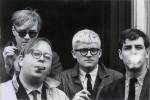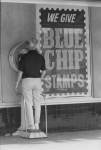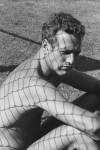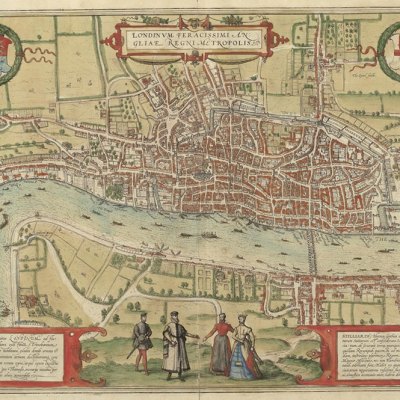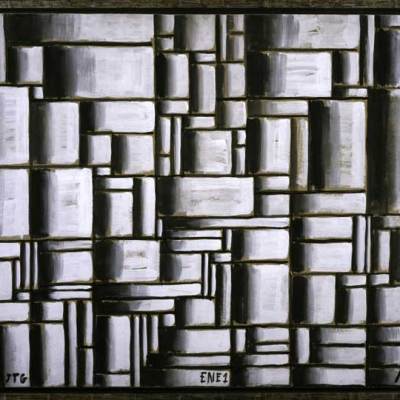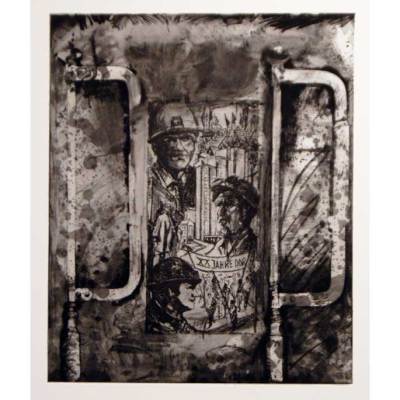Self Portrait in a Headlamp is an enigmatic photograph. It would be even more mysterious without the title, which anchors its suspended orb and spectral reflections to the concrete reality of a car’s bumper. Slightly distorted in a convex headlamp is a street scene that anticipates the subject matter of other photographs in this room; figures on a sidewalk, a road, cars, shops, signs, sky. But it is the two figures silhouetted in the foreground of this all-American tableau that command our attention. And especially the figure crouched on one knee, the man with the camera, who makes his elegant female companion linger as he captures the something that has caught his eye – their own reflections. This is Dennis Hopper, the photographer responsible for the dreamlike image itself.
The lesser-known photographic fruits of the 1960s Hollywood rebel’s artistic life are currently on display at the Royal Academy of Arts, London. Self Portrait in a Headlamp (1961–7) is the first photograph in ‘Dennis Hopper: The Lost Album’, and the only self-portrait in an exhibition full of outstanding portraits; of darlings of the screen and leviathans of the art scenes in LA and New York, of hippy girls and Hell’s Angels, and of ordinary people. Nevertheless, the shadowy presence of this man hiding behind the lens haunts every other image in the show.
Hopper’s photographs can be read as a visual essay on image-making – on looking and framing, and the possibilities for narration and abstraction inherent in these selective processes. His photographs are seductive because they are so knowing. Particularly fascinating in this regard are his portraits of artists – images of other image-makers –many of them commissioned for openings at the Ferus and Dwan galleries in LA. A photograph of Peter Blake (1964) recreates a meta-portrait; Blake’s bearded three-quarter profile peers out from behind a photograph that Hopper’s is evidently restaging. The earlier likeness floats at the front of the portrait’s frame, perhaps held by Hopper himself.
The Factory (Andy in Mirror) (1963), is a group portrait featuring Andy Warhol that also engages in a playful dialogue around framing, using mirrors as props. The confusion it creates about what is real and what is reflection captures something of the glamorous cult of the image that pervaded Andy Warhol’s Factory: images are fleeting, deceptive, skin-deep.
Manifest in Hopper’s photographs is the split personality of photography; its documentary integrity co-exists paradoxically with its illusory potential. Hopper’s own remarks on his work reinforce his chosen medium’s claim to being both art and a snapshot of real life. He desired ‘to document something. I wanted to leave something that I thought would be a record’, but he also talked of his work in terms of art; ‘I am an Abstract Expressionist by nature and a Duchampian finger pointer by choice.’
Hopper’s Duchampian tendencies can be seen in the photographs he takes of shop window assemblages – configurations of mannequins and merchandise made surreal by reflections from the street. Elsewhere, a photo of a Pollock drip-painting can be read as a playful engagement with an updated paragone; is photography conquering Abstract Expressionist painting or thirsting after it? Yet Hopper’s Abstract Expressionist identity independently reveals itself in his own photographic equivalent of drip painting. His striking close-ups abstract their subjects (which include bedsprings, banisters, torn posters, rusty coils and corkscrews, crushed leaves, cloth stretched over wire) into pure pattern.
Nevertheless, the documentary creeps into these abstract images. As Ed Ruscha observed, ‘Dennis always responded to city anxiety, graffiti, etchings on walls, expressing the frustration of urban life’. The faceless head and shoulder outlines in Effaced Double Poster (1961) – like an ominous echo of a tiled Warhol portrait – is a record of the degraded urban fabric that also alludes to a simultaneous wearing out of human souls. And here again is the recurring motif of the shadowy silhouette, recalling the man with the camera in Self Portrait in a Headlamp.
Hopper’s presence can furthermore be felt in the arrangement of these works, which echoes their original installation in his first major solo show, at Fort Worth Art Center in Texas, 1970. The recurring themes of his photographs – the power of images, youth and its expressiveness, commodities and ephemerality – ebb and flow throughout the exhibition, making suggestive connections between photos with an astonishing variety of subjects; billboards, artists, street-scenes, bullfighters, hippies, children, the television, neon signs, performances. Almost nowhere to be seen amongst this riot, Hopper is in fact everywhere.
‘Dennis Hopper: The Lost Album’ is at the Royal Academy of Arts, London, until 19 October.
Related Articles
Stars in whose eyes? The lack of women artists in Bailey’s Stardust (Elizabeth Grant)

